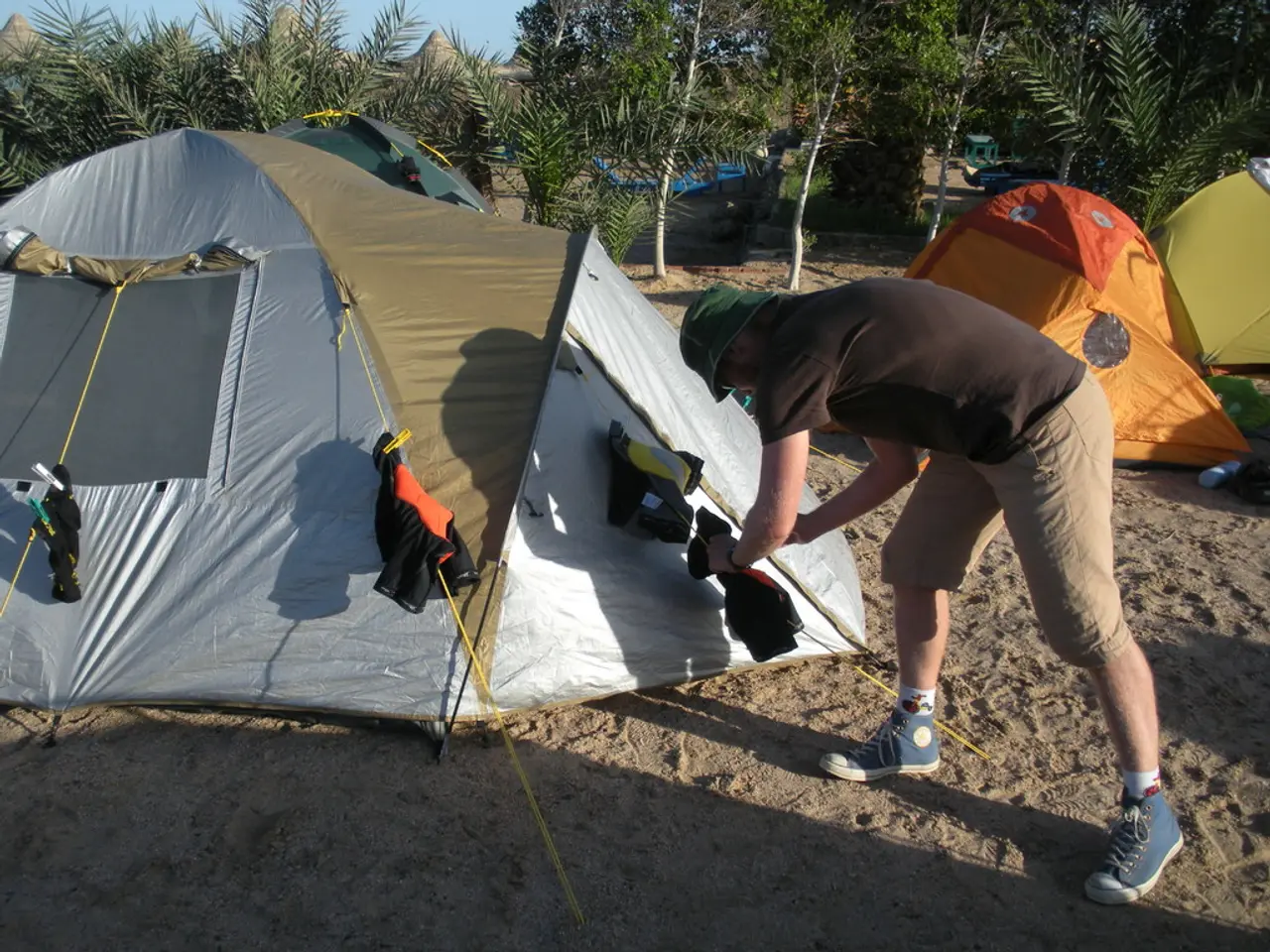"Over 50 Practical Backpacking Tips to Enhance Your Hiking Experience"
Preparing for a Comfortable and Safe Backpacking Trip
For an enjoyable and memorable backpacking experience, follow these key tips to select appropriate gear, pack smartly, manage food and water wisely, and practice good trail etiquette.
Gear Selection:
Choose supportive, waterproof hiking boots and moisture-wicking clothing such as synthetic or wool socks and T-shirts. Essential equipment includes a lightweight backpacking stove, water purification device (e.g., water filter), sleeping bag and pad, tent with rainfly, headlamp with spare batteries, and a first aid kit. Opt for multi-purpose gear and ultralight comfort items like a small pillow or camp shoes to enhance the experience while minimising weight[1][2].
Packing:
Pack in layers by frequency of use; place rarely used items (sleeping bag, camp shoes, extra layers) at the bottom, heavier items (food, stove, tent) in the middle close to your spine for balance, and frequently used items (rain jacket, first aid kit, water purification) at the top for easy access. Use compression sacks or packing cubes for organisation and reduced bulk[4].
Food and Water:
Plan your calories and water carefully. Carry 2–4 litres of water daily, know refill points, and bring a reliable water filter. Pack lightweight, high-calorie foods. Use bear-proof containers or hang food caches properly in bear country[1][2].
Trail Etiquette:
Follow Leave No Trace principles: pack out all trash, minimise impact on wildlife and vegetation, yield to other hikers appropriately, keep noise low, and stay on designated trails. Inform someone of your itinerary before departure for safety reasons[5].
Additional Safety Tips:
Check weather forecasts before the trip, carry navigation tools like maps, compass, or trail apps, and always have safety gear such as a whistle, multi-tool, and emergency shelter. In bear country, carry bear spray accessible outside your pack[2][3].
Other Practical Tips:
- Focus on enjoying the trip and taking in the scenery, rather than just crushing miles[6].
- Always carry a power bank for electronics, as phones handle maps, notes, photos, and emergency contact. A small power bank offers multiple charges and keeps devices running throughout the trip[7].
- Drink enough water throughout the day so you're not getting thirsty, as dehydration can lead to fatigue and other issues[8].
- Test trail meals at home before packing them to learn cooking times and taste[9].
- Go on day hikes. Do a full test pack before your trip and go on a few short hikes with it. This will not only be great training, it will also show you if something rubs the wrong way on your backpack[10].
- Layered clothing preferred. We don't bring a lot of clothes or "options"-we bring layers that work together. A sun hoodie, a merino wool base layer, and a rain jacket can handle most conditions[11].
- Share the itinerary. Always create a simple trip itinerary and share it with someone you trust. We list our planned route, campsites, trailhead info, and when we expect to be back[12].
- Use a mini Bic lighter for backpacking trips, as it is lightweight and lasts longer than a regular lighter[13].
- Break in your shoes before your hike. Wear them on short walks, local trails, or even around the house. And if they hurt now, they're not going to magically feel better after 20 miles-they're the wrong pair[14].
- Consider cold soaking meals to save weight and simplify your setup, although it may not be suitable for everyone[15].
- Scout water sources before hitting the trail using apps like onX Backcountry, AllTrails Pro, or Google Maps to avoid dry stretches and conserve water[16].
- Wrap tape around your lighter or trekking pole for easy access to blister tape or duct tape for repairs[17].
By following these tips, you'll maximise comfort, safety, and enjoyment on the trail. Happy backpacking!
[1] https://www.rei.com/learn/expert-advice/backpacking-gear-checklist.html [2] https://www.rei.com/learn/expert-advice/backpacking-safety-tips.html [3] https://www.nps.gov/subjects/planyourvisit/wildlife-safety.htm [4] https://www.rei.com/learn/expert-advice/backpacking-packing-tips.html [5] https://lnt.org/learn/7-principles [6] https://www.rei.com/learn/expert-advice/backpacking-tips.html [7] https://www.rei.com/learn/expert-advice/backpacking-electronics.html [8] https://www.rei.com/learn/expert-advice/backpacking-hydration.html [9] https://www.rei.com/learn/expert-advice/backpacking-food-planning.html [10] https://www.rei.com/learn/expert-advice/backpacking-training.html [11] https://www.rei.com/learn/expert-advice/backpacking-clothing.html [12] https://www.rei.com/learn/expert-advice/backpacking-safety-tips.html [13] https://www.rei.com/learn/expert-advice/backpacking-stove-fuel.html [14] https://www.rei.com/learn/expert-advice/backpacking-shoe-selection.html [15] https://www.rei.com/learn/expert-advice/backpacking-meal-preparation.html [16] https://www.rei.com/learn/expert-advice/backpacking-water-filters.html [17] https://www.rei.com/learn/expert-advice/backpacking-first-aid.html [18] https://www.rei.com/learn/expert-advice/backpacking-entertainment.html
- For a comfortable and safe backpacking trip, consider supportive hiking boots and moisture-wicking clothing like synthetic or wool socks and T-shirts.
- To enhance the experience while minimising weight, opt for multi-purpose gear such as a small pillow or camp shoes, and ultralight comfort items.
- When packing, place rarely used items at the bottom, heavier items close to your spine for balance, and frequently used items at the top for easy access.
- Carefully plan your calories and water, carrying 2–4 litres of water daily and packing lightweight, high-calorie foods.
- Follow Leave No Trace principles and practice good trail etiquette, minimising impact on wildlife, vegetation, and other hikers.
- Always inform someone of your itinerary before departure, checking the weather forecasts before the trip and carrying navigation tools like maps, compass, or trail apps.
- Other practical tips include carrying a power bank for electronics, drinking enough water throughout the day, and testing trail meals at home before packing them.




